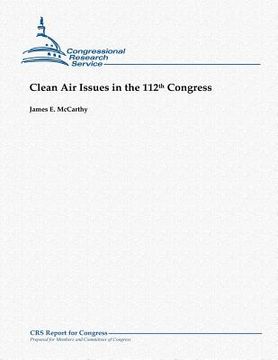Synopsis "Clean Air Issues in the 112th Congress"
Air quality has improved substantially in the United States in the 40 years of EPA's Clean Air Act regulation, but more needs to be done, according to the agency's science advisers, to protect public health and the environment from the effects of air pollution. Thus, the agency continues to promulgate regulations addressing air pollution using authority given it by Congress more than 20 years ago. In the 112th Congress, Members from both parties have raised questions about the cost effectiveness of some of these regulations and/or whether the agency has exceeded its regulatory authority in promulgating them. Others in Congress have supported EPA, noting that the Clean Air Act, often affirmed in court decisions, has authorized or required the agency's actions. EPA's regulatory actions on greenhouse gas (GHG) emissions have been one focus of congressional interest. Although the Obama Administration has consistently said that it would prefer that Congress pass new legislation to address climate change, such legislation now seems unlikely. Instead, over the last three years, EPA has developed GHG regulations using its existing Clean Air Act authority. EPA finalized GHG emission standards for cars and light trucks on April 1, 2010, and on August 28, 2012, and for larger trucks on August 9, 2011. The implementation of these standards, in turn, triggered permitting and Best Available Control Technology requirements for new major stationary sources of GHGs. It is the triggering of standards for stationary sources (power plants, manufacturing facilities, etc.) that has raised the most concern in Congress: legislation has been considered in both the House and Senate aimed at preventing EPA from implementing these requirements. In the first session of this Congress, the House passed H.R. 1, which contained provisions prohibiting the use of appropriated funds to implement various EPA GHG regulatory activities, and H.R. 910, a bill that would repeal EPA's endangerment finding, redefine "air pollutants" to exclude greenhouse gases, and prohibit EPA from promulgating any regulation to address climate change. In the Senate, H.R. 1 was defeated, and an amendment identical to H.R. 910 (S.Amdt. 183) failed on a vote of 50-50. EPA has taken action on a number of other air pollutant regulations, generally in response to court actions remanding previous rules. Remanded rules have included the Clean Air Interstate Rule (CAIR) and the Clean Air Mercury Rule-rules designed to control the long-range transport of sulfur dioxide, nitrogen oxides, and mercury from power plants through cap-and-trade programs. Other remanded rules included hazardous air pollutant ("MACT") standards for boilers and cement kilns. EPA is addressing the court remands through new regulations, that have now been promulgated. Many in Congress view the new regulations as overly stringent. The House has passed three bills (H.R. 2250, H.R. 2401, and H.R. 2681) to delay or revoke the new standards and change the statutory requirements for their replacements. In addition to the power plant and MACT rules, EPA is also reviewing ambient air quality standards (NAAQS) for ozone, particulates, and other widespread air pollutants. These standards serve as EPA's definition of clean air, and drive a range of regulatory controls. The revised NAAQS also face opposition in Congress. As passed by the House, H.R. 2401 would amend the Clean Air Act to require EPA to consider feasibility and cost in setting NAAQS, and H.R. 1633 would prevent EPA from setting standards for ambient concentrations of rural dust.

